Plasmas
"Plasma is the fourth state of matter, consisting of electrons, ions and neutral atoms, usually at temperatures above 104 degrees Kelvin."[1]
Astronomy
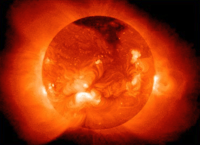
In physics and chemistry, plasma is a state of matter similar to gas in which a certain portion of the particles are ionized.
Theoretical plasmas
Def. a "state of matter consisting of partially ionized gas"[2] is called a plasma.
Def. an ionized gas consisting of positive ions and free electrons in proportions resulting in more or less no overall electric charge is called a plasma.
Electrons
"[P]lasma is a state of matter similar to gas in which a certain portion of the particles are ionized. Heating a gas may ionize its molecules or atoms (reduce or increase the number of electrons in them), thus turning it into a plasma, which contains charged particles: positive ions and negative electrons or ions.[3]"[4]
"For plasma to exist, ionization is necessary. The term "plasma density" by itself usually refers to the "electron density", that is, the number of free electrons per unit volume. The degree of ionization of a plasma is the proportion of atoms that have lost or gained electrons, and is controlled mostly by the temperature. Even a partially ionized gas in which as little as 1% of the particles are ionized can have the characteristics of a plasma (i.e., response to magnetic fields and high electrical conductivity). The degree of ionization, α is defined as α = ni/(ni + na) where ni is the number density of ions and na is the number density of neutral atoms. The electron density is related to this by the average charge state <Z> of the ions through ne = <Z> ni where ne is the number density of electrons."[4]
Lightning
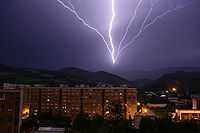
Lightning is an atmospheric discharge of electricity, which typically occurs during thunderstorms, and sometimes during volcanic eruptions or dust storms.
Magnetohydrodynamics
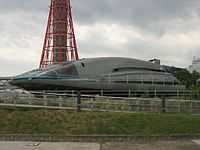
“The word magnetohydrodynamics (MHD) is derived from magneto- meaning magnetic field, and hydro- meaning liquid, and -dynamics meaning movement.”[5]
Nucleosynthesis
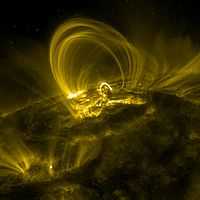
"Nucleosynthesis is the process of creating new atomic nuclei from pre-existing nucleons (protons and neutrons)."[6]
"A fundamental question in nuclear physics is what combinations of neutrons and protons can make up a nucleus. Many hundreds of exotic neutron-rich isotopes have never been observed; the limit of how many neutrons a given number of protons can bind is unknown for all but the lightest elements1, owing to the delicate interplay between single particle and collective quantum effects in the nucleus."[7]
"No published theoretical calculation has been able to simultaneously reproduce both the oxygen and fluorine driplines."[8]
Plasma objects

A plasma object may be simply an object consisting of mobile charged particles.
Auroras
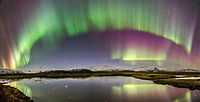
Auroras can be caused by electrons being absorbed into an atmosphere.
The "dramatic panorama [on the right shows a colorful], shimmering auroral curtain reflected in a placid Icelandic lake. The image was taken on 18 March 2015 by Carlos Gauna, near Jökulsárlón Glacier Lagoon in southern Iceland."[9]
"The celestial display was generated by a coronal mass ejection, or CME, on 15 March. Sweeping across the inner Solar System at some 3 million km per hour, the eruption reached Earth, 150 million kilometres away, in only two days. The gaseous cloud collided with Earth’s magnetic field at around 04:30 GMT on 17 March."[9]
"When the charged particles from the Sun penetrate Earth's magnetic shield, they are channelled downwards along the magnetic field lines until they strike atoms of gas high in the atmosphere. Like a giant fluorescent neon lamp, the interaction with excited oxygen atoms generates a green or, more rarely, red glow in the night sky, while excited nitrogen atoms yield blue and purple colours."[9]
"Auroral displays are not just decorative distractions. They are most frequent when the Sun's activity nears its peak roughly every 11 years. At such times, the inflow of high-energy particles and the buffeting of Earth’s magnetic field may sometimes cause power blackouts, disruption of radio communications, damage to satellites and even threaten astronaut safety."[9]
Hydrogens

Molecular hydrogen gas is excited in the discharge tube shown on the right. When an electron returns to a lower energy orbital state the purple color is observed.
Ions
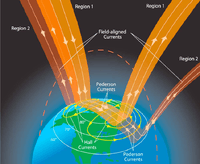
An ion is an atom or molecule with a net electric charge due to the loss or gain of one or more electrons.
Def. "[a]n atom or group of atoms bearing an electrical charge such as the sodium and chlorine atoms in a salt solution"[10] is called an ion.
Coronal clouds

A coronal cloud is a cloud, or cloud-like, natural astronomical entity, composed of plasmas and usually associated with a star or other astronomical object where the temperature is such that X-rays are emitted. While small coronal clouds are above the photosphere of many different visual spectral type stars, others occupy parts of the interstellar medium (ISM), extending sometimes millions of kilometers into space, or thousands of light-years, depending on the size of the associated object such as a galaxy.
Technology
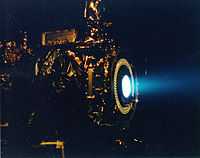

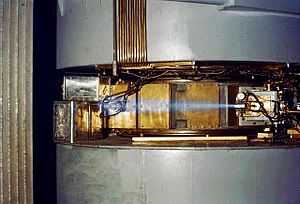
The image in the center shows a blue glow in the surrounding air from emitted cyclotron particulate radiation.
At left is an image that shows the blue glow resulting from a beam of relativistic electrons as they slow down. This deceleration produces synchrotron light out of the beam line of the National Synchrotron Light Source.
"Plasma cleaning involves the removal of impurities and contaminants from surfaces through the use of an energetic plasma created from gaseous species. Gases such as argon and oxygen, as well as mixtures such as air and hydrogen/nitrogen are used. The plasma is created by using high frequency voltages (typically kHz to >MHz) to ionise the low pressure gas (typically around 1/1000 atmospheric pressure), although atmospheric pressure plasmas are now also common."[11]
Original research
- See also: Original research inquiry and Research
Hypothesis:
- A plasma has at least 2 % electrons or positive ions per total number of particles.
- Charge balance is not required for a plasma.
- See also: Control groups, Proof of concept, and Proof of technology
See also
References
- ↑ CK Birdsall, A. Bruce Langdon (October 1, 2004). Plasma Physics via Computer Simulation. New York: CRC Press. pp. 479. ISBN 0-7503-1035-1. http://books.google.com/books?hl=en&lr=&id=S2lqgDTm6a4C&oi=fnd&pg=PR13&ots=nOPXyqtDo8&sig=-kA8YfaX6nlfFnaW3CYkATh-QPg. Retrieved 2011-12-17.
- ↑ "plasma, In: Wiktionary". San Francisco, California: Wikimedia Foundation, Inc. 6 February 2015. Retrieved 2015-04-10.
- ↑ Q-Z Luo, N. D'Angelo, R. L. Merlino (1998). Shock formation in a negative ion plasma. 5. Department of Physics and Astronomy. http://www.physics.uiowa.edu/~rmerlino/nishocks.pdf. Retrieved 2011-11-20.
- 1 2 "Plasma (physics), In: Wikipedia". San Francisco, California: Wikimedia Foundation, Inc. July 5, 2012. Retrieved 2012-07-06.
- ↑ "Magnetohydrodynamics, In: Wikipedia". San Francisco, California: Wikimedia Foundation, Inc. October 1, 2012. Retrieved 2012-11-14.
- ↑ "Nucleosynthesis, In: Wikipedia". San Francisco, California: Wikimedia Foundation, Inc. December 20, 2012. Retrieved 2013-01-17.
- ↑ T. Baumann, A. M. Amthor, D. Bazin, B. A. Brown, C. M. Folden III, A. Gade, T. N. Ginter, M. Hausmann, M. Matoš, D. J. Morrissey, M. Portillo, A. Schiller, B. M. Sherrill, A. Stolz, O. B. Tarasov & M. Thoennessen (October 25, 2007). "Discovery of 40Mg and 42Al suggests neutron drip-line slant towards heavier isotopes". Nature 449 (7165): 1022-4. doi:10.1038/nature06213. http://www.nature.com/nature/journal/v449/n7165/full/nature06213.html. Retrieved 2013-01-18.
- ↑ Z. Kohley, A. Spyrou, E. Lunderberg, P. A. DeYoung, H. Attanayake, T. Baumann, D. Bazin, B. A. Brown G. Christian, D. Divaratne, S. M. Grimes, A. Haagsma, J. E. Finck, N. Frank, B. Luther, S. Mosby, T. Nagi, G. F. Peaslee, W. A. Peters, A. Schiller, J. K. Smith, J. Snyder, M. J. Strongman, M. Thoennessen, and A. Volya (August 14, 2012). "Exploring the neutron dripline two neutrons at a time: The first observations of the 26O and 16Be ground state resonances". arXiv preprint. http://arxiv.org/abs/1208.2969. Retrieved 2013-01-18.
- 1 2 3 4 European Space Agency (09 April 2015). "Aurora over Icelandic Lake". ESA. Retrieved 2015-04-12.
- ↑ Trunkie (14 September 2004). "ion, In: Wiktionary". San Francisco, California: Wikimedia Foundation, Inc. Retrieved 2014-12-08.
- ↑ "Plasma cleaning, In: Wikipedia". San Francisco, California: Wikimedia Foundation, Inc. April 13, 2013. Retrieved 2013-05-28.
External links
![]() This is a research project at http://en.wikiversity.org
This is a research project at http://en.wikiversity.org
| |
Educational level: this is a research resource. |
| |
Resource type: this resource is an article. |
| |
Resource type: this resource contains a lecture or lecture notes. |